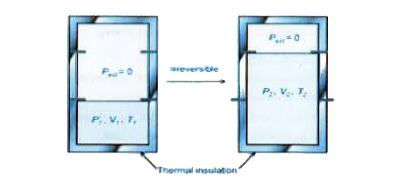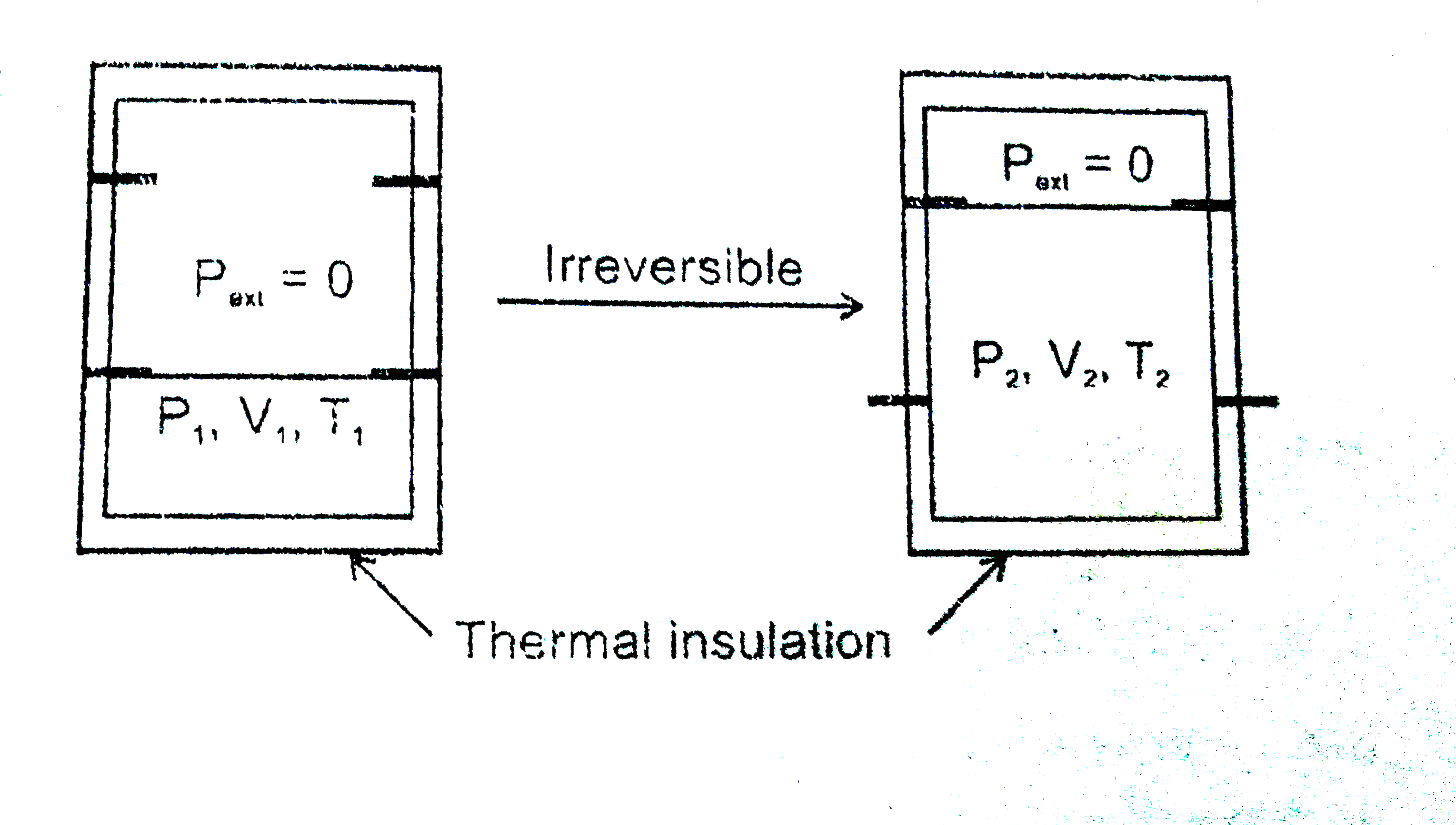Two containers of equal volume contain the same gas at pressure P1 and P2 and absolute temperature T1 and T2, respectively. On joining the vessels, the gas reaches a common pressure P and common temperature T. The ratio P/T is equal to
P1T1+P2T2
P1T1+P2T2(T1+T2)2
P1T2+P2T2(T1+T1)2
P12T1+P22T2
The correct Answer is:D
To solve the problem, we will use the ideal gas law and the concept of combining gases in two containers. Here’s a step-by-step breakdown of the solution:
Step 1: Define the Variables
Let:
- Volume of each container = V
- Pressure in the first container = P1
- Temperature in the first container = T1
- Pressure in the second container = P2
- Temperature in the second container = T2
Step 2: Calculate the Number of Moles in Each Container
Using the ideal gas law PV=nRT, we can express the number of moles in each container.
For the first container:
n1=P1VRT1
For the second container:
n2=P2VRT2
Step 3: Total Number of Moles After Joining the Containers
When the two containers are joined, the total volume becomes 2V. The total number of moles after joining the containers is:
n=n1+n2=P1VRT1+P2VRT2
Step 4: Express Total Number of Moles in Terms of Final Pressure and Temperature
After joining, the total number of moles can also be expressed in terms of the final pressure P and temperature T:
n=P(2V)RT
Step 5: Set the Two Expressions for Total Moles Equal
Now we set the two expressions for n equal to each other:
P1VRT1+P2VRT2=P(2V)RT
Step 6: Cancel Common Terms
We can cancel V and R from both sides:
P1T1+P2T2=2PT
Step 7: Rearranging to Find the Ratio PT
Rearranging the equation gives:
PT=12(P1T1+P2T2)
Final Result
Thus, the ratio PT is:
PT=12(P1T1+P2T2)
Let:
- Volume of each container = V
- Pressure in the first container = P1
- Temperature in the first container = T1
- Pressure in the second container = P2
- Temperature in the second container = T2
Using the ideal gas law PV=nRT, we can express the number of moles in each container.
n1=P1VRT1
n2=P2VRT2
When the two containers are joined, the total volume becomes 2V. The total number of moles after joining the containers is:
n=n1+n2=P1VRT1+P2VRT2
After joining, the total number of moles can also be expressed in terms of the final pressure P and temperature T:
n=P(2V)RT
Now we set the two expressions for n equal to each other:
P1VRT1+P2VRT2=P(2V)RT
We can cancel V and R from both sides:
P1T1+P2T2=2PT
Rearranging the equation gives:
PT=12(P1T1+P2T2)
Thus, the ratio PT is:
PT=12(P1T1+P2T2)
Topper's Solved these Questions
- KINETIC THEORY OF GASES AND FIRST LAW OF THERMODYNAMICSBOOK - CENGAGE PHYSICS ENGLISHCHAPTER - KINETIC THEORY OF GASES AND FIRST LAW OF THERMODYNAMICSEXERCISE - Multiple Corrects
29 Videos
- KINETIC THEORY OF GASES AND FIRST LAW OF THERMODYNAMICSBOOK - CENGAGE PHYSICS ENGLISHCHAPTER - KINETIC THEORY OF GASES AND FIRST LAW OF THERMODYNAMICSEXERCISE - Assertion-Reasoning
6 Videos
- KINETIC THEORY OF GASES AND FIRST LAW OF THERMODYNAMICSBOOK - CENGAGE PHYSICS ENGLISHCHAPTER - KINETIC THEORY OF GASES AND FIRST LAW OF THERMODYNAMICSEXERCISE - Subjective
22 Videos
- KINETIC THEORY OF GASESBOOK - CENGAGE PHYSICS ENGLISHCHAPTER - KINETIC THEORY OF GASESEXERCISE - Compression
2 Videos
- LINEAR AND ANGULAR SIMPLE HARMONIC MOTIONBOOK - CENGAGE PHYSICS ENGLISHCHAPTER - LINEAR AND ANGULAR SIMPLE HARMONIC MOTIONEXERCISE - Single correct anwer type
14 Videos
Similar Questions
Two vessels of volume (V1)and(V2) contain the same ideal gas. The pressures in the vessels are (P1)and(P2) and the temperatures are (T1)and(T2) respectively . The two vessels are now connected to each other through a narrow tube. Assuming that no heat is exchanged between the surrounding and the vessels, find the common pressure and temperature attained after the connection.
View SolutionTwo idential container joined by a small pipe initially contain the same gas at pressure p0 and absolute temperature T0. One container is now maintained at the same temperature while the other is heated to 2T0. The common pressure of the gas
View Solution
Knowledge Check
Two cylinder having m1g and m2g of a gas at pressure P1 and P2 respectively are put in cummunication with each other, temperature remaining constant. The common pressure reached will be
AP1P2(m1+m2)P2m1+P1m2BP1P2m1P2m1+P1m2Cm1m2(P1+P2)P2m1(P1+P2)Dm1m2P2P2m1+P1m2A sample of an ideal gas occupies a volume V at pressure P and absolute temperature T. The masss of each molecule is m, then the density of the gas is
AmKTBPmKTCPkmDPKT
An ideal gas has pressure P, volume V and temperature T. Select the correct option.
View SolutionAn ideal gas in a thermally insulated vessel at internal pressure = P1, volume =V1 and absolute temperature =T1 expands irreversibly against zero external pressure, as shown in the diagram. The final internal pressure, volume and absolute temperature of the gas are P2,V2andT2, respectively. For this expansion.

View SolutionAn ideal gas in a thermally insulated vessel at internal pressure =P1, volume =V1 and absolute temperature =T1 expands irreversibly against zero external pressure, as shown in the diagram. The final internal pressure, volume and absolute temperature of the gas are P2,V2 and T2 respectively. For this expansion.

View SolutionAn ideal gas in a thermally insulated vessel at internal pressure =P1, volume =V1 and absolute temperature =T1 expands irreversibly against zero external pressure, as shown in the diagram. The final internal pressure, volume and absolute temperature of the gas are P2,V2 and T2 respectively. For this expansion.

View SolutionTwo identical containers joned by a small pipe initially contain the same gas at pressue po and abosolute temperature To. One container is now mantained at the same temperature while the other is heated to 2T0. The commmon pressure of the gases will be
View SolutionTwo adiabatic containers have volumes V1 and V2 respectively. The first container has monoatomic gas at pressure p1 and temperature T1. The second container has another monoatomic gas at pressure p2 and temperature T2. When the two containers are connected by a narrow tube, the final temperature and pressure of the gases in the containers are P and T respectively. Then
View Solution